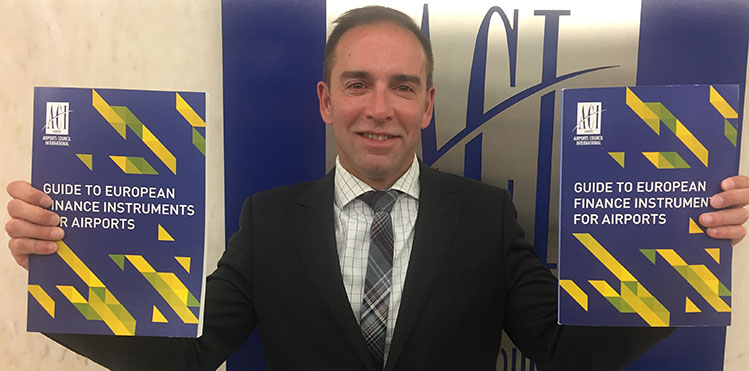The 10th ACI EUROPE Regional Airports Conference & Exhibition took place on 15-17 May in Cork, hosted by Cork Airport. Over 170 representatives from airports, airlines, industry suppliers and institutional stakeholders participated in this year’s event, which was on the theme of ‘A New Era of Engagement and Digital Innovation’. Inês Rebelo reports.
Cork Airport is on a roll. Having recently secured Norwegian and Wow Air’s transatlantic flights making it ‘Europe’s newest transatlantic airport’, it hosted this year’s ACI EUROPE Regional Airports Conference & Exhibition on 15-17 May.
The Conference, which celebrated its 10th anniversary, was preceded by a meeting of ACI EUROPE’s Regional Airports’ Forum. Its Chair, Alberto Martin Rodriguez, Aena’s outgoing Director of Gran Canaria Airport, stepped down from his two-year term and has been succeeded by Henri Hansson, Senior Vice President, Technical and Environmental Services, Finavia, as the new Chair of the Forum. Niall MacCarthy, the Managing Director of Cork Airport was elected Vice-Chair.

Cork Airport & ACI EUROPE celebrating 10 years of ACI EUROPE Regional Airports Conference & Exhibition.
Speaking of the conference, MacCarthy said “Cork Airport is delighted and proud to host this very important conference in Cork. Not only was it a fantastic opportunity for delegates, exhibitors and speakers alike to engage and share their views on the future of our industry, it was also a unique opportunity for us to showcase our region to an influential international audience. I am very confident the dividends from our hosting of the ACI EUROPE Regional Airports Conference & Exhibition will lead to long-standing relationships with a view to growing our business further at Cork Airport.”

Niall MacCarthy, Managing Director Cork Airport; Deirdre Clune, Member of the European Parliament, Committee on Transport and Tourism; Filip Cornelis, Acting Director, Air Transport, DG MOVE, European Commission; Olivier Jankovec, Director General ACI EUROPE.
And indeed, true to his word, Cork Airport showcased its exceptionally collaborative links with various business partners in the region, with social events at the Jameson Midleton Distillery and the renowned Castlemartyr Hotel.
Over the 2 days of conference, with air transport expert John Strickland as Chair (for the fourth year in a row) there were panel sessions that saw European regional airports address a plethora of topical issues, ranging from ‘owning the customer using digital’ and ‘regional tourism engagement’ to ‘the transatlantic challenge’, EASA and employee engagement. The discussions were held with experts from the airport industry and aviation partners, including Robert Sinclair, CEO of Bristol Airport; Peter Kearney, Director ATM Operations & Strategy Irish Aviation Authority (IAA); Emilia De Santis, Terminal Manager & PH Terminal, Naples International Airport; Anthony Martin, Managing Director VINCI Airports, and Ulrich Heppe, CEO Fraport Bulgaria.

Marina Bylinsky, Environmental Strategy & Intermodality Manager ACI EUROPE, explaining the benefits for regional airports to participate in Airport Carbon Accreditation.
Regional connectivity
With Keynote Addresses by Deirdre Clune, the region’s Member of the European Parliament, Committee on Transport and Tourism, and by Filip Cornelis, Acting Director, Air Transport, DG MOVE, European Commission, air connectivity and Brexit were also discussed. In this regard, Deirdre Clune underlined the importance of airports in order for regions to remain competitive and the benefits of local connectivity, recognising that Brexit will present EU aviation with a big challenge. Cornelis emphasised how air connectivity is a central theme of the EU Aviation Strategy and the pivotal role of the Single EU Aviation Market, set up 25 years ago, in increasing the network of air routes in Europe. “Before the existence of the Single EU Aviation Market, there were 10 routes from Cork. Now, more than 35 routes are operated from Cork, including travelling to the US.” He added “Connectivity brings growth and dynamism to small medium-sized cities – thanks to regional airports.”
Connectivity is undeniably one of the key factors of the economic development generated by regional airports, so maintaining it and increasing it is the best way to stimulate investment and growth. The potential of the low cost long haul services opens an optimistic window of opportunities for some regional airports, as Olivier Jankovec, Director General ACI EUROPE, pointed out in his State of the Industry presentation. However, Jankovec warned that Brexit along with changes in airline business models, may jeopardise the activity of regional airports. Over the past years, since Ryanair started operating from more primary airports, ACI EUROPE has noted an 11% reduction in the number of bases it has at regional airports.
The perils of Brexit
With 15.4% of the EU-27’s regional airports with less than 1 million passengers per year being the most dependent on UK traffic, Brexit poses connectivity and business disruption risks to these airports in particular. ACI EUROPE assured its regional airport members that it continues to highlight the implications for the aviation market between the EU and the UK post-Brexit to the EU’s Brexit negotiating team.
Green is a regional colour
In his welcome address, Alberto Martín Rodriguez, outgoing Chair of the Regional Airports’ Forum and Director of Aena’s Gran Canaria Airport, stated that environmental responsibility is one of the key duties of regional airports and he reminded them of their role in increasing airport sustainability. He underlined that the airport industry committed to actively tackling climate change 9 years ago with the launch of ACI EUROPE’s initiative Airport Carbon Accreditation, the only global carbon management standard for airports. “This programme comprises airports of all sizes operating under various different business models and among the 31 carbon neutral airports in the world, 12 have less than 6 million passengers, and 4 of them less than 500,000 passengers. All 12 of those airports are regional airports located here in Europe,” he underlined.
Evidently, there is a growing culture of regional airports doing their part when it comes to reducing their carbon emissions. The total number of regional Carbon Accredited Airports in Europe is now up to 87, which corresponds to 45.5% of the current 189 certified airports worldwide by Airport Carbon Accreditation. Nevertheless, it is imperative that regional airports continue to pursue these environmental efforts and that Europe’s regional airport community as a whole effectively responds to climate challenges, realising its environmental commitment to the farthest extent possible. In this regard, Marina Bylinsky, Environmental Strategy & Intermodality Manager ACI EUROPE, explained why regional airports should embark on an environmental journey towards carbon neutrality and how their participation in Airport Carbon Accreditation can help them achieve it. “Today more than ever, to earn their licence to operate, airports of all sizes need to actively contribute to reducing the climate impact of aviation. Airport Carbon Accreditation helps them adopt a proactive and long-term approach to carbon management while also providing a framework for its public recognition,” Marina noted.

Delegates experienced the best of Celtic musical heritage at the Gala Dinner.
EU funding possibilities for regional airports
In addition to the limitations imposed by size, fixed costs, regulatory constraints and the dominant position of some air carriers, access to EU funding represents a major challenge for regional airports.
According to ACI EUROPE, regional airports provide 1,890,000 direct, indirect and induced jobs in Europe, contributing €84.5 billion GDP. Given the economic value of regional airports and the strategic role of regional connectivity to boost businesses and jobs, access to EU funding becomes an essential tool for regional airports to compete and innovate.
With this in mind, ACI EUROPE officially released its brand new Guide to European Finance Instruments for Airports at the Regional Airports Forum meeting on 15 May. With vital information from the European Union’s Multiannual Financial Framework 2014-2020 and other sources, the Guide provides an extensive overview of European funding possibilities for airports, the instruments and mechanisms currently available, the type of assistance provided and contacts for the relevant people within each organisation. “With this Guide, ACI EUROPE intends to help its regional airport members identify the European funding opportunities available with the hope of encouraging them to apply for it and, eventually, benefit from it in order to modernise their airport infrastructures and operations. This will better empower regional airports to continue to be a driving force of economic growth in their regions,” Federico Bonaudi, Facilitation, Parliamentary Affairs & Regional Airports Manager ACI EUROPE, said.

Federico Bonaudi, ACI EUROPE’s Manager for Facilitation, Parliamentary Affairs & Regional Airports, presenting ACI EUROPE’s Guide to Finance Instruments for Airports.
The Guide can be downloaded from www.aci-europe.org.
The 11th ACI EUROPE Regional Airports Conference & Exhibition will take place on 14-16 May 2018 in Naples, hosted by Naples International Airport.







